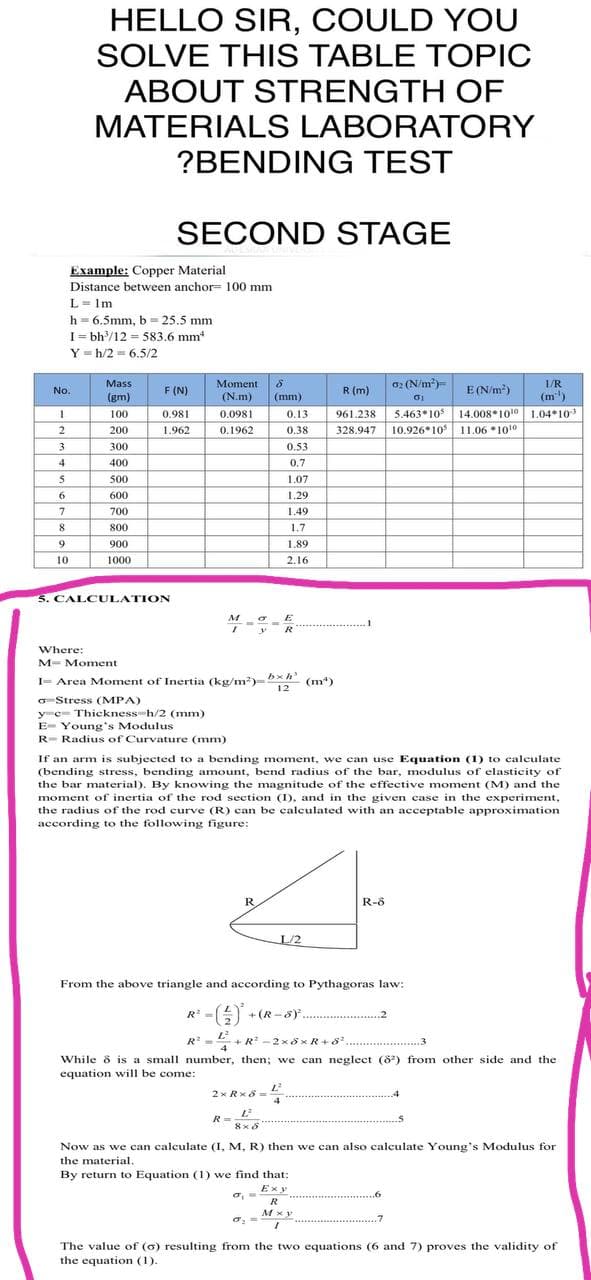SOLVE THIS TABLE TOPIC ABOUT STRENGTH OF MATERIALS LABORATORY ?BENDING TEST SECOND STAGE Example: Copper Material Distance between anchor= 100 mm L= Im h=6.5mm, b 25.5 mm I= bh/12 = 583.6 mm Y = h/2 = 6.5/2
SOLVE THIS TABLE TOPIC ABOUT STRENGTH OF MATERIALS LABORATORY ?BENDING TEST SECOND STAGE Example: Copper Material Distance between anchor= 100 mm L= Im h=6.5mm, b 25.5 mm I= bh/12 = 583.6 mm Y = h/2 = 6.5/2
Mechanics of Materials (MindTap Course List)
9th Edition
ISBN:9781337093347
Author:Barry J. Goodno, James M. Gere
Publisher:Barry J. Goodno, James M. Gere
Chapter5: Stresses In Beams (basic Topics)
Section: Chapter Questions
Problem 5.5.9P: A seesaw weighing 3 lb/ft of length is occupied by two children, each weighing 90 lb (see figure)....
Related questions
Question

Transcribed Image Text:HELLO SIR, COULD YOU
SOLVE THIS TABLE TOPIC
ABOUT STRENGTH OF
MATERIALS LABORATORY
?BENDING TEST
SECOND STAGE
Example: Copper Material
Distance between anchor= 100 mm
L= Im
h = 6.5mm, b 25.5 mm
I= bh/12 = 583,6 mm
Y = h/2 = 6.5/2
Mass
F (N)
Moment
02 (N/m)=
E (N/m?)
1/R
No.
R (m)
(gm)
(N.m)
(mm)
(m")
5.463*10 14.008*1010 1.04*10
10.926* 10 11.06 *1010
100
0.981
0.0981
0.13
961.238
2
200
1.962
0.1962
0,38
328.947
300
0.53
4
400
0,7
500
1.07
6.
600
1.29
7
700
1.49
8.
800
1.7
9
900
1.89
10
1000
2.16
5. CALCULATION
R
Where:
M- Moment
I- Area Moment of Inertia (kg/m)-x (m)
12
o Stress (MPA)
ye= Thickness h/2 (mm)
E- Young's Modulus
R- Radius of Curvature (mm)
If an arm is subjected to a bending moment, we can use Equation (1) to calculate
(bending stress, bending amount, bend radius of the bar, modulus of elasticity of
the bar material). By knowing the magnitude of the effective moment (M) and the
moment of inertia of the rod section (I), and in the given case in the experiment,
the radius of the rod curve (R) can be calculated with an acceptable approximation
according to the following figure:
R
R-8
L/2
From the above triangle and according to Pythagoras law:
R' -
A
+ (R-8) .2
L
E+R -2 x 8xR+8 .3
R
While & is a small number, then; we can neglect (8) from other side and the
equation will be come:
2xRx8 = L
.4
L
R =
8x8
Now as we can calculate (I, M, R) then we can also calculate Young's Modulus for
the material.
By return to Equation (1) we find that:
Ex y
R
.7
The value of (6) resulting from the two equations (6 and 7) proves the validity of
the equation (1).
Expert Solution
This question has been solved!
Explore an expertly crafted, step-by-step solution for a thorough understanding of key concepts.
Step by step
Solved in 5 steps with 10 images

Knowledge Booster
Learn more about
Need a deep-dive on the concept behind this application? Look no further. Learn more about this topic, mechanical-engineering and related others by exploring similar questions and additional content below.Recommended textbooks for you

Mechanics of Materials (MindTap Course List)
Mechanical Engineering
ISBN:
9781337093347
Author:
Barry J. Goodno, James M. Gere
Publisher:
Cengage Learning

Mechanics of Materials (MindTap Course List)
Mechanical Engineering
ISBN:
9781337093347
Author:
Barry J. Goodno, James M. Gere
Publisher:
Cengage Learning